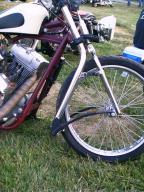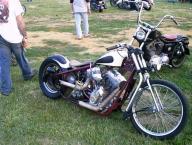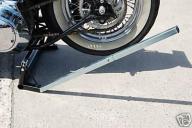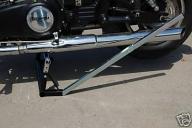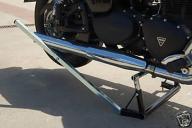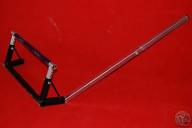-
Număr conținut
2.627 -
Înregistrat
-
Ultima Vizită
Tip conținut
Profiluri
Forumuri
Calendar
Orice postat de Ancalagon
-
Super tare! Poti face o aripa spate pentru o Volusia? Cam cu cat?
-
La multi ani! Acum am vazut ca esti din aceeasi luna cu mine... Si timisorean, doar ca mai tanar... keep the good work...
-
Nu-mi trimit si mie una?
-
Ai dreptate in ceea ce priveste problema "sfaturilor" tip Confederate ot Berceni, ha... Ar fi fain sa gasesti un vas de expansiune mai interesant, nu prea are fata ala de plastic original de pe dreapta. Astept cu interes sistemul de evacuare...
-

Harley Davidson Sportster 1200 Low - Brontozaurul
topic a răspuns lui Ancalagon în ddmkroul Motocicleta mea
Eu nu posed un Harley, dar am mers cu cateva, cele mai multe fiind sportstere - intr-o zi am comparat unul cu curea fata de altul mai old-school pe lant, tot la cilindreea de top. Trebuie sa te obisnuiesti cu fieratania, dar ai fi surprins ce poti sa faci si cu un sporster "ne-sportiv" cum zici tu. Clear your mind you should, my young padawan... -

Sfintirea motoarelor 2009
topic a răspuns lui Ancalagon în meistergicaul POZE & FILME - Intalniri moto in ROMANIA
http://www.thisiskent.co.uk/news/Biking-Do...il/article.html Asa, sa zicem ca e un exemplu celebru... Un preot englez fondand chiar un club de motociclisti. Pe de alta parte, religia e o "fosila ideologica vie" - e treaba fiecaruia ca se lasa manipulat de religie, comunism, manelism, sau neotziganismul tarziu... Ortodoxia contemporana e un kitsch evident si cineva avea dreptate sa spuna undeva mai sus ca ii vine sa rada. Din pacate, lipsa de gust si educatie la noi e atat de grava incat nu e de gluma. Daca cei "100 de motociclisti" care s-au adunat acolo ne spun ceva, ne spun doar ca libertatea e folosita pentru promovarea kitsch-ului. Ce poate fi mai kitsch decat sfintirea unei motociclete? Hello? -

Transalpina - offroad pentru ultima data
topic a răspuns lui Ancalagon în alexxxul Poze & Filme - Arhive 2005 - 2013
E greu sa spui cum e mai bine. Eu mi-am petrecut o parte din acest an in Anglia - tara care e asa cum s-a spus pe undeva, asfaltata sau macar bine nivelata si intretinuta pe toate potecutele. Natura e transformata intr-un fel de parc - frumos, dar parca ochiului meu obisnuit cu zonele virgine inca de pe la noi nu-i prea placea. Pe de alta parte, diferenta dintre sat si oras nu mai exista - celebrul vis a lui Ceausescu a fost infaptuit de cei mai vechi capitalisti, hehe... Nivelul de trai e superior si pentru ca ultimul colt al tarii a fost scos din bezna. Nivelul de trai ridicat va schimba si modul de a se face turism, in sensul ca se vor face si mai multi bani si tot asa. Noi astia cu nostalgiile noastre suntem deja niste dinozauri, anarhisti cu GPS-uri rataciti in tranzitie... Sunt mandru de mine, dar ma simt tot mai nedumerit intr-o lume in care e mai ieftin sa faci in concediu un circuit din UK in Japonia, Noua Zeelanda si retur decat o vacanta la Marea Neagra. Ce-ar zice saracul James Cook? Kangooroo, kangooroo... -
Mi se pare mai cinstit sa iei mecanica si s-o pui pe un cadru de chopper sau cafe racer. Arata mai bine in final... Dar nah - de gustibus... Constructorii nu s-au gandit la estetica daca oricum ascundeau aproape tot sub carenaje, deci nu prea arata bine decat ca ratbike mad max style..
-
NU. N-are motor, it's worthless. Nu e moral sa fiu si motor si pilot in acelasi timp...
-
Daca faceti abstractie de sotia creatorului, iata niste forme mai ciudate de furca fata... Si cam cum ar trebui sa functioneze, destul de rigid dupa parerea mea: http://s20.photobucket.com/albums/b222/riv...nt=4d79988b.pbr
-
Focking strange bike - keep the good work... Cred ca mai trebuie facut ceva la ea, dar mi se pare aiurea sa dau sfaturi - you must feel the Force around you...
-
La nivel de motoare "pentru tot poporul" diferenta e minima - injectia e preferata, ca dealtfel si racirea cu apa la motociclete pentru ca e mai usor sa obtii un regim constant si noxe mai scazute. La constructorii de motoare nu le pasa cum pornesti tu iarna ci sa treaca de testele de poluare ca sa-si vanda masinile. Cu carburatorul era tot mai greu, pe masura ce legile s-au tot inasprit si atunci toti au trecut pe injectie. Cate masini aveau injectie pana nu a aparut gogorita asta cu emisiile de CO2? Cateva, de lux, sau supersport... Deci avem injectie pentru reducerea poluarii si, ca un efect secundar consumam mai putin si avem cai mai multi pe aceeasi cilindree, pentru ca motorul are un regim optimizat. La carburatoare era o arta sa gasesti compromisul ideal... Pentru performante, nu e destul sa ai injectie, ci un sistem integrat care sa-ti coreleze tot timpul parametrii motorului - "mapping" - cu momentul si durata injectiei. De pilda, senzorii lambda care informeaza asupra compozitiei gazelor din evacuare vor determina prelungirea(imbogatirea amestecului) injectiei sau scurtarea(saracirea). Sau injectia suplimentara de aer in admisie. Sau alte manevre iscusite. Computerul face orice, cu conditia sa ai un soft bine facut si cat mai multe informatii. Si daca totul mai e facut si de japonezi, va tine probabil destul de mult. Daca iti place insa stilul clasic, carburatorul e alegerea ta - la customuri e chiar un element de design, il vezi scos pe lateral, lustruit, cu filtru cromat, etc..
-
Si inca unul s-a mai dus... As avea o propunere - am vazut mai sus fotografia lui Radu - ar fi o treaba buna sa facem un topic memorial, cum ati vazut poate si pe site-urile de cluburi de pe afara, doar fotografia si cateva date esentiale... Pentru toti cei plecati dintre noi in eternal ride...
-
Eu mi-as face un chopper... Am tinut eu seama de reguli vreodata?
-
C'mon, vulpeacan nu ajunge la struguri - sau la HD - zice ca-s acri... Cum dracu' sa nu-ti placa HD? Poate nu-ti place pretul dar atunci, nah... fura unu'. doar suntem romani, ce dracu'... Poate vreunu' din becalii aia din primaverii poate nici nu observa, hehe..
-

Honda Shadow Black Spirit, raspunsul japonezilor la Iron 883
topic a răspuns lui Ancalagon în paul_bikerul Chopper
Foarte greu faci o motocicleta "clasicoida" sa arate bine daca motorul e racit cu apa - eu nu inteleg de ce nu gasesc o solutie mai eleganta la mascarea radiatorului ala care strica tot aspectul. Ar putea sa-l puna in alta parte si sa faca un cadru mai simplu - pentru ca de aici pleaca toata frumusetea si linia unui motor. Cadrele japonezilor sunt functionale, solide, dar urate ca dracu'.... In rest, numai de bine, motociclete serioase din punct de vedere tehnic... Am vazut un Shadow chopperit, cu radiatorul mutat in spatele motorului, cadrul simplu leagan si incepea sa se apropie de ce ne place.... -
Ce ma bucur ca ai facut Shovelu', in sfarsit...
-

Moto Life ia o pauza de cateva luni
topic a răspuns lui Ancalagon în Cristi Stanescuul Revista MotoLife
Cristi, chiar imi pare foarte rau... Eu sunt plecat din tara si tot aflu chestii nasoale in fiecare zi. Sper sa o repui pe picioare.. -
Mai bine ni-l aratai pe cel original... Asta e cam prea minimalist - as fi interesat cum se comporta pe drum... Arata ca un cross "retro".
-
Un memento bun: legea si birocratia pot conduce la genocid....
-
Da, da, cu slick-uri in sus pe Raul Caselor - not for gay, fireste.... Dincolo de eterna controversa 2T vs 4T, ce dracu' e cu apocalipsa aia? Vine sau nu vine? Si daca vine, cu ce vine? Cu supermoto in 2 sau in 4 timpi? Sincer, cosmin_kill, waddafuck? Explica-ne si noua care-i intelesul ascuns sau ezoteric a ceea ce scrii acolo...
-
Hallo, domnu Speedy, v-ati spurcat cu Harley garajul? Criza mare?
-
Mergeti la Sf. Gheorghe, ai plaja 30 de km... Iar la faza cu nudismul sa ne sufle...
-
"Cric" de chopper... Poate ca nu e home-made, dar pentru niste oameni descurcareti cu flexul is sudura, nu cred ca e greu de "clonat":



